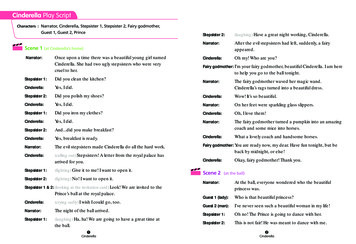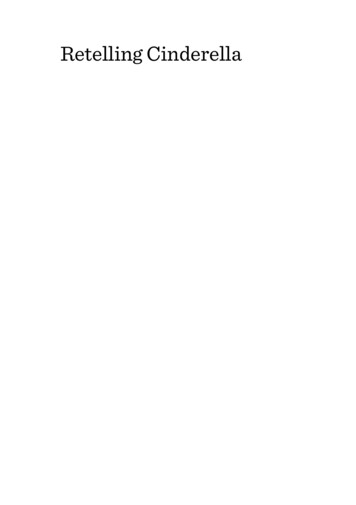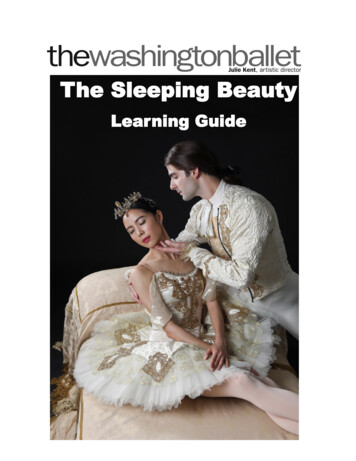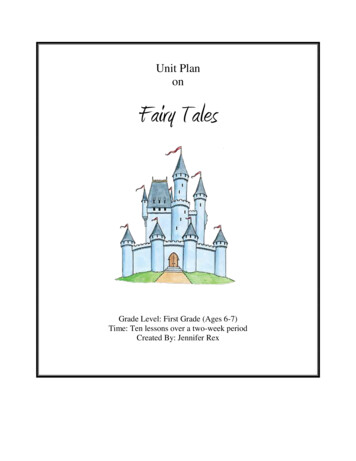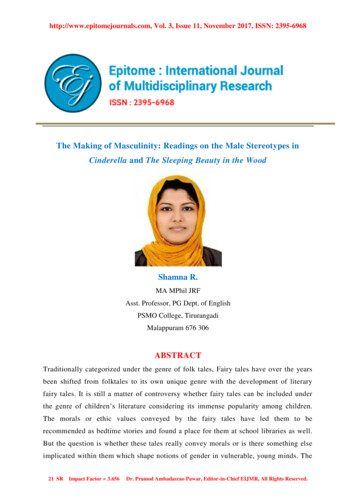
Transcription
http://www.epitomejournals.com, Vol. 3, Issue 11, November 2017, ISSN: 2395-6968The Making of Masculinity: Readings on the Male Stereotypes inCinderella and The Sleeping Beauty in the WoodShamna R.MA MPhil JRFAsst. Professor, PG Dept. of EnglishPSMO College, TirurangadiMalappuram 676 306ABSTRACTTraditionally categorized under the genre of folk tales, Fairy tales have over the yearsbeen shifted from folktales to its own unique genre with the development of literaryfairy tales. It is still a matter of controversy whether fairy tales can be included underthe genre of children‟s literature considering its immense popularity among children.The morals or ethic values conveyed by the fairy tales have led them to berecommended as bedtime stories and found a place for them at school libraries as well.But the question is whether these tales really convey morals or is there something elseimplicated within them which shape notions of gender in vulnerable, young minds. The21 SR Impact Factor 3.656Dr. Pramod Ambadasrao Pawar, Editor-in-Chief EIJMR, All Rights Reserved.
http://www.epitomejournals.com, Vol. 3, Issue 11, November 2017, ISSN: 2395-6968pattern of enchantment and disenchantment of these tales seem so conventional andcommon that we do not question the implications. So it is worth analyzing how thegender stereotypical concepts are weaved into such tales that implicitly set standards ofbehaviour and attributes for young boys who obviously admire and yearn to be like theRoyal figures.KEYWORDSgender, stereotypes, masculinity, Cinderella, Sleeping BeautyRESEARCH PAPERTraditionally categorized under the genre of folk tales, Fairy tales have over the yearsbeen shifted from folktales to its own unique genre with the development of literaryfairy tales. It is still a matter of controversy whether fairy tales can be included underthe genre of children‟s literature considering its immense popularity among children.The morals or ethic values conveyed by the fairy tales have led them to berecommended as bedtime stories and found a place for them at school libraries as well.But the question is whether these tales really convey morals or is there something elseimplicated within them which shape notions of gender in vulnerable, young minds. Thepattern of enchantment and disenchantment of these tales seem so conventional andcommon that we do not question the implications. So it is worth analyzing how thegender stereotypical concepts are weaved into such taleslike Perrault‟s Cinderella andThe Sleeping Beauty in the Wood.Femininity has long been understood by theorists largely as a social construction. Buton the other hand, masculinity has undergone less scrutiny and is therefore oftenunquestioned, and considered as something common or usual, and a continued focus onthe female gender as primary subject for the study of gender in children's literature is anunhealthy practice which would lead to perpetuating the idea that girls are constructedwhile boys are just naturally boys. Hence we find most scholars in the field ofmasculinity studies echoing Simone de Beauvoir in varying degrees by claiming thatmen "are made, not born". Feminism itself never excludes studies and analysis ofhegemonic masculinity which damages boys and men as much as it damages girls andwomen. “The current fixation on boys is also clearly a reaction to recent progress22 SR Impact Factor 3.656Dr. Pramod Ambadasrao Pawar, Editor-in-Chief EIJMR, All Rights Reserved.
http://www.epitomejournals.com, Vol. 3, Issue 11, November 2017, ISSN: 2395-6968feminists have made and our hopes or uncertainties about the future direction ofaccepted gender roles.” (Wannamaker 5).In fact, feminists gain from studies on hegemonic masculinity as it persuades more menand boys to accept versions of masculinity that are not based on the oppression ofwomen or showcasing of the so-called masculine traits. Therefore, it isn‟t feminism thatsuffocates and pressurizes men, but patriarchy which puts too much pressure on boysand men to be unemotional, tough or in other words, non-feminine. This pressure isoften met by male gender by conforming at the stake of their emotional well -being. Thisstudy takes into account liberal feminists who consider the welfare and education ofboys as equally important as girls. But there are other non -liberal feminists who areless concerned about boys‟ welfare as “Attempts to raise the issue of boys‟ difficultiesare often received skeptically by many feminists who have worked so hard to expose thebias against girls”. (Wannamaker 5)One of the major aims of masculinity studies is to create a general awareness thatmasculinity is to an extent created by the society and hence alterable. However, to saythat gender is entirely constructed by society and culture is just as deterministic asclaiming that gender, is entirely shaped by biology. And if masculinity was a naturalresult of biology, “ boys would not need to police gendered behaviors of themselvesand their peers on the playground, and boys and men would not need to continuouslyprove that they are not feminine.” (Wannamaker 128)While female characters in fairy tales like Perrault‟s Cinderella and The SleepingBeauty in the Wood are judged by their physical appearance, male characters are judgedbased on their actions. However, understanding and foregrounding the w ay masculinityfunctions in popular children‟s literature are vital to discourage portrayal ofstereotypical gender roles as “The books we claim will most benefit our boys are thosebooks that reinforce whichever version of masculinity we most value” (Wann amaker4)And this would gradually lead to the birth of 'handicapped' men in the society. Forsuch boys, expressing emotions or being seen as sensitive is really complicated andundesirable as Wannamaker mentions in “Boys in Children's Literature and PopularCulture”, “Dominant constructions of masculinity that require boys to be stoic andunemotional damage boys‟ emotional health” ( 2).Male gender stereotypes are obviously coded as just the opposite of the femalestereotypes. Male stereotypes therefore include independence, aggression, insensitive,23 SR Impact Factor 3.656Dr. Pramod Ambadasrao Pawar, Editor-in-Chief EIJMR, All Rights Reserved.
http://www.epitomejournals.com, Vol. 3, Issue 11, November 2017, ISSN: 2395-6968confidence and sexual assertion as opposed to female stereotypes. Stereotypicaldepiction of male characters in fairy tales like Perrault‟s Cinderella, The SleepingBeauty in the Woodand the Grimm Brothers Snow White as brave, adventurous,domineering, confident young men who are in constant search for "beautiful" womenconstrain boys and do not allow them the broad range of emotions that they deserve oreven ways of expressing them freely.Children‟s literature thus indirectly establish strict rules about how the male as well asfemale sex should behave, rules which both genders genuinely fear breaking. The maleprotagonists in such popular fairy tales and juvenile literature also tend to be chosenfrom the upper class, mostly fair, charming Royal members: “Gay boys, poor boys, andminority boys are often invisible in popular texts or, worse, are presented as the Otheragainst which a protagonist‟s subjectivity is defined” (Wannamaker 8).And asWannamaker points out, “This doesn‟t mean, however, that white, middle class,heterosexual boys are the only ones reading, viewing, and consuming these texts orbeing affected by them” (9). The Prince of a fairy tale is always right and always winsby the end of the tale. Even when some of their actions may be assigned ascontroversial, they are never portrayed as the wrongdoers. And these flawless maleheroes have neither virtues nor vices, making them one dimensional, literallyemotionless character. When compared to female characters, at least female stereotypeshave either virtues of some kind or major flaws and they are never devoid of emotion.In Perrault's Cinderella, the Prince falls in love with beautiful Cinderella at first sight.He spends the entire night dancing away with her ignoring all the other maidens at theball. The next night also “the King‟s son was always by her, and never ceased hiscompliments and kind speeches to her” (3). Cinderella however runs off as the clockstrikes twelve. Here, we find the Prince simply waiting for the woman he apparentlyloves and when Cinderella runs off from the ball at midnight, he doesn't run behind heror try to find her himself with the help of the glass slipper. Instead he orders others totake the glass slipper and find her. This is probably a natural course of events as he is aPrince after all and always has servants to do his menial jobs, but it is still odd that thePrince does literally nothing by himself.The Prince never sees Cinderella in her rags and he does not choose her as his bride torescue her from her deprived condition, rather because he is charmed and dumb-struckby her beauty. And yet this one- dimensional character is presented as the prize at the24 SR Impact Factor 3.656Dr. Pramod Ambadasrao Pawar, Editor-in-Chief EIJMR, All Rights Reserved.
http://www.epitomejournals.com, Vol. 3, Issue 11, November 2017, ISSN: 2395-6968end of a difficult race. The male protagonist in Cinderella is thus depicted as the savioras in other fairy tales like Grimm Brother‟s Snow White and Hans Christian Andersen'sThe Little Mermaid despite the fact that most of the worthy efforts were made by thefemale protagonists through their virtues. Is the male protagonist then an apt or worthyrole model for young boys?Perrault has also made it a point to describe Cinderella‟s beauty by describing her as a“charming, pretty girl” who “danced gracefully” and “showed a thousand civilities” toher step sisters thus instilling into young boys‟ minds that feminine beauty is confinedto such superficial qualities. This issue is practically even worse and more evident inThe Sleeping Beauty in the Wood as the princess in this tale is picturized as “an angel,so fair was she to behold” whose “cheeks were delicately flushed, her lips like coral”.This sort of description of physical beauty generates two possible issues. One, there isan indirect encouragement of general preoccupation with physical appearances whichalso includes an emphasis on materialism and neglect of individual personality traits.Secondly, is Perrault implying that only fair women who have rosy-red lips arebeautiful? This seems to be the impression made upon any reader and thus boys developtheir idea on feminine beauty from such tales at a very young age. Unfortunately theidea that they develop on feminine beauty from these fairy tales is of „fair‟ women andthis impression automatically makes „dark‟ women be categorized as ugly.Perrault seems to have given all men liberty to gaze at women including the old King,“The king himself, old as he was, could not help watching her, and telling the queensoftly that it was a long time since he had seen so beautiful and lovely a creature.”(Cinderella, 2). It‟s not just liberty to gaze at women, but the tale also instills into boysmind that beauty is the most important quality in any woman and beauty is what is to beadmired and respected the most, “The King‟s son led her to the most honourable seat,and afterwards took her out to dance with him. She danced so very gracefully that theyall more and more admired her. ” (Cinderella, 4)The Prince in Disney's animated movie of Cinderella (1950) is just like the Princes inthe various versions of Cinderella- unemotional, yet handsome and rich which makeshim the most eligible bachelor in the Kingdom. His role is shorter than any othercharacter in the movie just as in Perrault's version of the story. And still he is clearly themain Hero of the story who apparently brings about the happy ending to beautifulCinderella's life.25 SR Impact Factor 3.656Dr. Pramod Ambadasrao Pawar, Editor-in-Chief EIJMR, All Rights Reserved.
http://www.epitomejournals.com, Vol. 3, Issue 11, November 2017, ISSN: 2395-6968The passive, submissive and pathetic depictions of female characters also affect boys asthey are not provided with strong female role models through them. It is equallyimportant for them to read tales with female protagonists rather than male heroes wholead female protagonists into a happy life through marriage, and practically nothingelse. Tales with female protagonists would probably encourage boys to accept women inleading roles in their life, while otherwise they may find it unusual and unacceptable.Apart from the fact that the male protagonist in the tale is overly obsessed with beautyand is also portrayed as the rescuer in the story although he literally does nothing exceptmarrying the beautiful Cinderella, he possess no other positive quality or emotion. Maleemotions are thus simplified to merely love and that too only for “fair” women whose“cheeks are delicately flushed” and have “lips like coral”. The Prince in Cinderella isliterally jobless and his only task seems to be to choose a fair and beautiful woman tomarry, which he does accomplish a bit too easily. Similarly in The Sleeping Beauty inthe Wood, the Prince is portrayed as weak and submissive before the “radiant beauty” ofthe Princess; “Trembling in his admiration he drew near and went on his knees besideher” (Sleeping Beauty, 4). And charmed by her beauty and the words she spoke, he waswonder struck, “The Prince scarcely knew how to express his delight and gratification.He declared that he loved her better than he loved himself. His words were faltering, butthey pleased the more for that.” (Sleeping Beauty, 5)Again boys are given the impression that they can easily charm and possess any womanwhom they take a fascination about. Rejection by women or fate is completely missingin these fairy tales, thus leading boys to grow into vain. Weak-willedmen wouldprobably be shocked by such rejections in the real world. The Prince in The SleepingBeauty in the Wood, however, is more active than the Prince in Cinderella. He merelyhears about a tale of hidden castle with a princess sleeping inside and he immediatelyfeels that he is all set for the adventure, for a Prince ought to be “young and gallant” inPerrault‟s words. He bravely cuts through great trees, bushes and brambles to reach thehidden castle. Upon entering, “.everything he saw might have frozen the most fearlessperson with horror. There reigned all over a most frightful silence; the image of deatheverywhere showed itself.” (Sleeping Beauty, 4)But the so-called “brave” Prince pushes on and finds a resplendent beauty, who awakesat his arrival. He immediately declares his undying love for her and marries the verysame day in the “castle chapel” without knowing how the Princess behaves, what her26 SR Impact Factor 3.656Dr. Pramod Ambadasrao Pawar, Editor-in-Chief EIJMR, All Rights Reserved.
http://www.epitomejournals.com, Vol. 3, Issue 11, November 2017, ISSN: 2395-6968personal attributes are or even how she came into such a state of sleep for so manyyears. He is however portrayed as a brave, passionate and gallant young man who easilybelieves tales told by others and thus ends up finding the beauty of his dreams.The Prince, however, does not embark upon the adventure to rescue the beautifulPrincess from her pathetic sleep or to liberate her from the evil spell of the wicked f airy,but he was “impelled alike by the wish for love and glory”. Perrault sets ineffective,hegemonic standards for Royalty through the representation of the Prince in TheSleeping Beauty in the Wood: “A young and gallant Prince is always brave.” (SleepingBeauty, 3) Thus, we find the tale implicitly setting standards of behaviour and attributesfor young boys who obviously admire and yearn to be like Princes. The choosing ofRoyal members like the Princess, Prince, King, Queen etc is to be noted as Royalty, andis always looked upon with admiration, respect and naturally, imitated by youngchildren. Then, what about those children who do not feel as brave as the Princes?Many boys may be much happy in doing household chores than going about like DonQuixote. But even these boys are tuned to believe that they have more of feminine traitsthan the so called masculine traits set by such fairy tales and other genres of literatureas well.Perrault successfully establishes male domination right from the beginning of TheSleeping Beauty in the Wood: “By the King‟s orders, a place was laid for her.”, and“The King in an attempt to avert the unhappy doom pronounced by the old fairy, at oncepublished an edict forbidding all persons, under pain of death, to use a spinning wheelor keep a spindle in the house” (Sleeping Beauty 2). In this case, the Queen isautomatically pushed to the back seat and given only secondary importance as it isevident through the above quotes that it is the King who makes all the importantdecisions. The Queen is thus erased from most scenes of significance.However, in The Sleeping Beauty in the Wood, the Prince hides his marriage with thePrincess from his mother. Despite the morals embedded in such fairy tales, boys areprobably encouraged to disregard and hide important information of their lives fromtheir mothers. And he does this only because she is an Ogre, a decision built merely ona prejudice. But as soon as he gains power as King of the country, he decides to revealhis marriage in front of the citizens and his mother, only because of the change in hispower:27 SR Impact Factor 3.656Dr. Pramod Ambadasrao Pawar, Editor-in-Chief EIJMR, All Rights Reserved.
http://www.epitomejournals.com, Vol. 3, Issue 11, November 2017, ISSN: 2395-6968But at the end of two years the King died, and the prince found himself on thethrone. He then made public announcement of his marriage, and went in state tofetch his Royal consort from her castle. With her two children beside her, sh emade a triumphal entry into the capital of her husband‟s realm.” (SleepingBeauty, 5)Motherhood is thus degraded in most of these fairy tales and simultaneously young boysare indirectly encouraged to disregard and neglect their own mothers. And despite hisdistrust in his ogress mother, he puts her in charge after bringing his wife and children,when he leaves on a journey. The Prince even attempts to murder his own mother. Thisis definitely not a moral value to be injected into a child. And when the P rince‟s motherfinally commits suicide by throwing herself into the vat or tub prepared for the Prince‟swife and children, “The Prince could not but be very sorry, for she was his mother; buthe soon comforted himself with his beautiful wife, and his pretty children.” (SleepingBeauty, 6)Is a “beautiful” wife and “pretty” children all that a person needs to comfort him andrelieve him from the death of his own mother? The unnecessary importance laid on theattribute of beauty here, again injects wrong impressions into young boys, who byreading such fairy tales would probably grow into individuals who believe beauty is theonly factor that determines their happiness in married life.In Disney‟s Sleeping Beauty (1959), however, the Prince is not exactly as brave orcapable as the one in Perrault's story. In the Disney version, the Prince is captured bythe evil fairy, Maleficent, and is left helpless until the good fairies appear and rescuehim. They also provide him with a sword and shield to get to his love and kiss her backto life. Although most of the so called brave, adventurous and heroic acts are done bythe good fairies, the Prince is portrayed as the one saves the day. And in the end, all hedid was „kiss‟ the Princess back to life.Despite the relatively poor and ineffective pictures portrayed by both the Princes inPerrault‟s and Disney versions of Cinderella and The Sleeping Beauty in the Wood, theyare highlighted as the heroes or rescuers who bring about the happy ending. Thus,through the portrayal of such male characters, fairy tales establish male domination orpatriarchy in other words. And at the same time, boys and young men are equallyaffected negatively by the so called masculine traits presented and established throughfairy tales like Cinderella and The Sleeping Beauty in the Wood. Though these28 SR Impact Factor 3.656Dr. Pramod Ambadasrao Pawar, Editor-in-Chief EIJMR, All Rights Reserved.
http://www.epitomejournals.com, Vol. 3, Issue 11, November 2017, ISSN: 2395-6968hegemonic males are portrayed as being brave, adventurous and royal, they also tend topossess very simple needs as well as emotions.There are obviously many boys and men who do not conform to the hegemonicmasculinity depicted in such tales. Hence these boys grow into men with a doubleconsciousness, with who they really are on one hand, and who they ought to beaccording to the norms of the society on the other hand. These so called norms of thesociety are embodied and reflected through forms of art like literature, dance, music etc.Therefore being „manly‟ is defined and filtered through the lens of this stereotypicaldepiction in art forms like fairy tales. And „manly‟ attributes can be summed up ascomprising of mainly three factors, namely, status, toughness and anti -feminism. Manyboys who do not conform to these so-called masculine traits are at times ridiculed,bullied and insulted both in real life and in literature. The character Neville Longbottomin J. K. Rowling‟s Harry Potter is an example for such victims of hegemonic notions ofgender.This leads us to the conclusion that hegemonic or stereotypical gender roles affect notjust females, but also males in an almost equal manner. But unfortunately, masculinityand issues related with it are neglected or often not even recognized:Changing the ways our culture perceives dominant masculinity, and thehierarchal systems constructed in relation to it, must first begin with markingmasculinity as a gender, making visible the ways it is both socially constructedand evolving, and creating spaces for child readers to see themselves as agents ofchange. (Wannamaker 148)Thus, Prince Charming has been deconstructed. Boys should therefore be provided withtexts that feature a wide variety of characters that represent different races, ethnicities,nationalities and most importantly, a number of ways of „being male‟, even though th isworks as only a part of the solution, “They should be reading texts featuring males, whoare nonviolent, sensitive, tolerant, and wise, not only those depicting males who areviolent, stoic and individualistic” (Wannamaker 15).William Brozo's book To be a Boy, To be a Reader: Engaging Teen and Preteen Boys inActive Literacy works to compile a list of books boys should be reading because theyfeature positive male role models that help to counter the negative stereotypical imagesthat boys come across in popular culture and literature. But there are few scholars like29 SR Impact Factor 3.656Dr. Pramod Ambadasrao Pawar, Editor-in-Chief EIJMR, All Rights Reserved.
http://www.epitomejournals.com, Vol. 3, Issue 11, November 2017, ISSN: 2395-6968Mc Gillis who considers fairytales as metaphors rather than as a guide to live in asociety:I suggest that the tales may liberate the reader from existing social structu res bytransforming those social structures into metaphor. The fairy tale world is ametaphor of a possible reality, not an imitation of reality or a blueprint of reality.(Wannamaker 14)However, there are novels like J.K. Rowling‟s Harry Potter which opens up morepossibilities for boys by portraying broader definitions of what it means to be masculineand also by giving readers characters and situations that test the constructed borders ofgender. Thus in Harry Potter we find the hero, Harry leading a Cinderella-like life ofdeprivation and submissive helplessness initially. There are of course otherstereotypical characters in Harry Potter, but at least the male protagonist is not one ofthose typical stereotypes.But why are fairy tales like Cinderella and The Sleeping Beauty in the Wood still sopopular? Probably because their reinforcement of hegemonic notions of gender makesreaders feel comfortable as it instills the belief that they don‟t pose challenges to theexisting state of affairs in the society. This might not be the sole reason, but maybe justa small part of the reasons for the undeterred popularity. Other more obvious reasonswould be the magical elements and the “happily ever after” endings that attract youngminds to such tales.Completely re-modifying and re-signifying masculinity and femininity is an almostUtopian or rather difficult aim, mainly because gender construction is always crafted ina concealed manner and literature alone cannot undertake such a huge task. But it wouldbe a relief to read and imagine about „real‟ characters who are not too perfect, andthereby believable and likeable, contrasted to the perfect, manly Prince‟s and heroes.30 SR Impact Factor 3.656Dr. Pramod Ambadasrao Pawar, Editor-in-Chief EIJMR, All Rights Reserved.
http://www.epitomejournals.com, Vol. 3, Issue 11, November 2017, ISSN: 2395-6968WORKS CITEDBeauvoir, Simone de.The Second Sex, transl. H.M. Parshley. London: Lowe and Brydon,1956.Brow, Lindsay. “Fairy Tales Few Dare to Tell: Breaking Molds and Gender Stereotypesthrough Sexuality in Lost Girls”. English 494.73-77.Daftuar, Swati. “A Twist in the Tale”.The Hindu 07 July 2013:1.Disney, Walt.Cinderella.Dir. Clyde Geronimi. Prod. Walt Disney Animation Studios. 1950.Film. , Sleeping Beauty.Dir. Les Clark. Prod. Walt Disney Animation Studios. 1959. Film.Haviland, Virginia. Children and Literature: Views and Reviews. Illinosis: Scott, Foresmanand Co, 1973.H.Colwell, Eileen.”Folk Literature and Fantasy” - Folk Literature: An Oral Tradition and anOral Art - Illinosis: Scott, Foresman and Co, 1973. 206-212.Hunt, Peter. Children’s Literature : The Development of Criticism. New York: Routledge,1990.Kuykendal, Leslee Farish and Brian W. Storm. “We Said Feminist Fairy Tales, Not FracturedFairy Tales”. Children and Libraries.38-41.Neikirk, Alice. “ Happily Ever After(or What Fairytales Teach Girls About Being Women)”. Anthropolgy 324 Essay. 38-42Oberskein, Karin Lesnik. Children’s Literature : New Approaches. New York: PalgraveMacmillan, 2004.Perrault, Charles. Old-Time Stories.Trans. A.E. Johnson. New York: Dodd, Mead & Co.,1922.Perrault, Charles. The Fairy Tales of Charles Perrault.Trans. Robert Samber and J.E.Mansion. London: George.G.Harrap& Co., 1922. Print.Salih, Sarah. Judith Butler: Routledge Critical Thinkers essential guides for literary studies.New York: Routledge, 2008.Tiwari, Shubha. Children and Literature. New Delhi: Atlantic Publishers, 2006.Thillainayagam, S. Feminist Literary Essays. New Delhi: Indian Publishers, 1999.Wannamaker, Annette. Boys in Childrens Literature and Popular Culture:MasculinityAbjection and the Fictional Child. New York: Routledge, 2008.Zipes, Jack. “Feminism and Fairy Tales” – Don’t Bet on the Prince – New York: Routledge,1986. 209-223.31 SR Impact Factor 3.656Dr. Pramod Ambadasrao Pawar, Editor-in-Chief EIJMR, All Rights Reserved.
The Sleeping Beauty in the Wood. Femininity has long been understood by theorists largely as a social construction. But on the other hand, masculinity has undergone less scrutiny and is therefore often unquestioned, and considered as something common or usual, and a continued focus on the female gender as primary subject for the study of gender .






